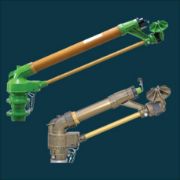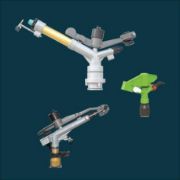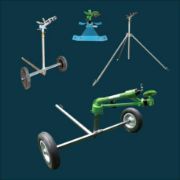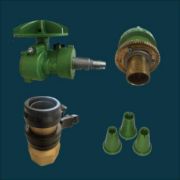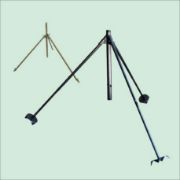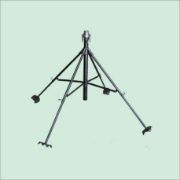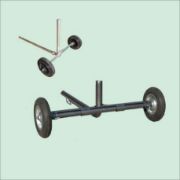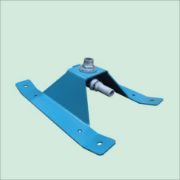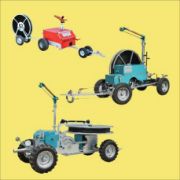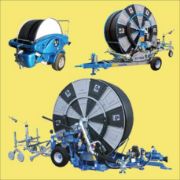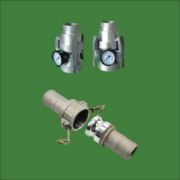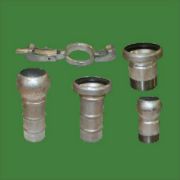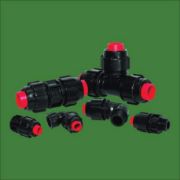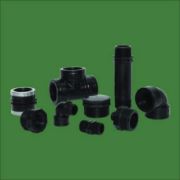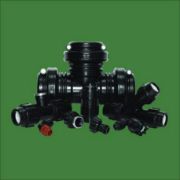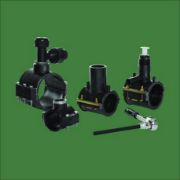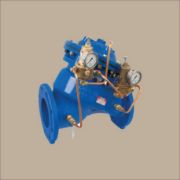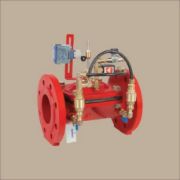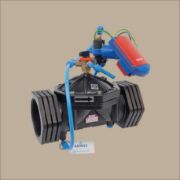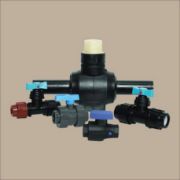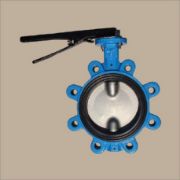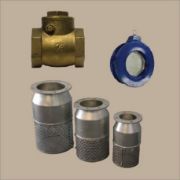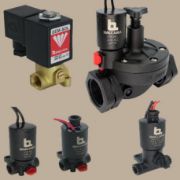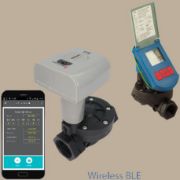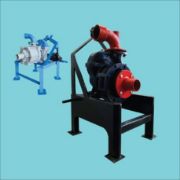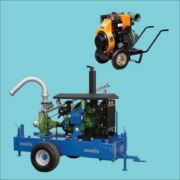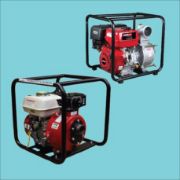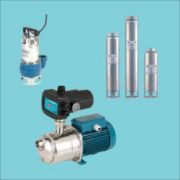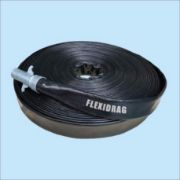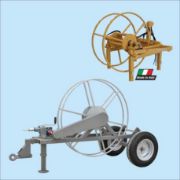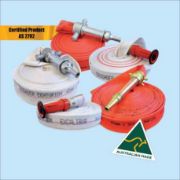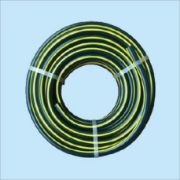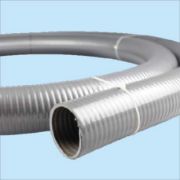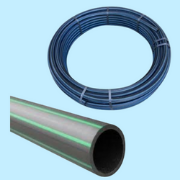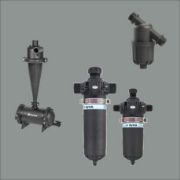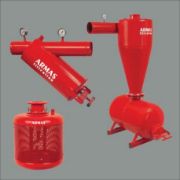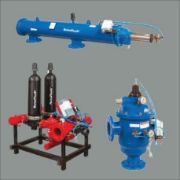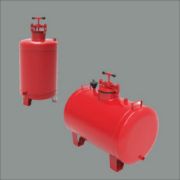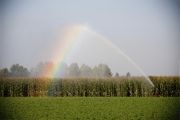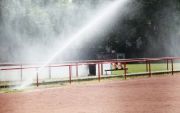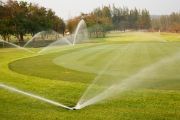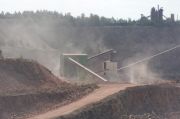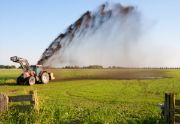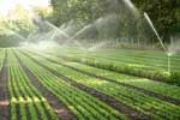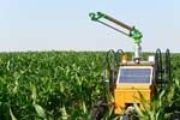Irrigation Glossary
a | b | c | d | e | f | g | h | i | j | k | l | m | n | o | p | q | r | s | t | u | v | w | x | y | z
See also unit descriptions. When applicable, commonly used measurement units are included in brackets. Example: [in, ft].
A
Application Efficiency
The ratio of the water that is stored in the root zone for later use by the plants to the total water applied. [%, decimal]
Available Water Capacity (AWC)
Also known as available water (AW). The portion of water in a soil that can be readily absorbed by plant roots. It is the amount of water between field capacity and permanent wilting point. Usually measured in either %, in/ft, in/in, mm/mm, or m/m.
B
Backflow Prevention Device
Used to prevent the flow of water from the water distribution system back to the water source and may be required by law. Similar to anti-siphon valves.
Basin Irrigation
A surface irrigation method where water is applied to a completely level area surrounded by dikes. On high clay content soils and managed correctly basin irrigation can be very efficient.
Best Management Practice (BMP)
An irrigation practice that is both economical and practical that will assist in reducing water use, protect water quality, while maintaining or improving crop production.
Big Gun Systems
Uses a large sprinkler mounted on a wheeled cart or trailer, fed by a flexible rubber hose. The machine may be reeled in by the hose, or moved periodically. Big guns operate at high operating pressures in order to throw water long distances.
Border Irrigation
Water is applied at the upper end of a strip having parallel berms or earthen dikes anywhere from 10 to 100 feet apart that serve to confine the water to a strip or rectangular area.
Brake Horsepower
The power delivered by the motor to drive a pump.
C
Center Pivot Sprinklers
An automated irrigation system composed of a sprinkler lateral rotating around a pivot point and supported by a number of self-propelled towers. Water and power is supplied at the pivot point. They are easily identified from the air as large circular fields. Most center-pivots are one-quarter mile long and irrigate 128- to 132-acre circular fields. Center pivots are the most popular irrigation method in the U.S. because they require low labor input, are fairly reliable, are flexible with crop varieties and soils, can accommodate undulating terrain, are easily adapted for chemigation, and have the best uniformity and efficiency of any sprinkler irrigation system
Chemigation
The process of applying chemicals (fertilizers, insecticides, herbicides, etc...) to crops or soil through an irrigation system with the water.
Conveyance Efficiency
The ratio of the water that is delivered to a field to the total water diverted or pumped into the conveyance system at the upstream end. [%, decimal]
Corrugation Irrigation
Surface irrigation method where small channels or corrugations are used to guide water across a field. No attempt is made to confine the water entirely to the corrugations.
Crop Coefficient
A number that is multiplied by the potential evapotranspiration to obtain the actual crop or plant evapotranspiration. They are crop dependent numbers and change over time with the crop's growth stage. [unitless]
D
Deep Percolation
Movement of water downward through the soil profile below the root zone. This water is lost to the plants and eventually ends up in the groundwater. These water losses can be significant and are often out-of-site and therefore out-of-mind. [in, mm]
Deficit Irrigation
Not completely refilling the soil profile to field capacity. Not giving the plants all of the water that they can use. This may be deliberate, or inadvertent.
Distribution Uniformity
Test for determining the evenness or uniformity of irrigation water over an area. Numerical indices of uniformity include DU (distribution uniformity of the low quarter) and CU (Christiansen's coefficient of uniformity). [unitless]
Drip Irrigation
Also known as trickle or micro-irrigation. Water is applied at very low flow rates (drip) through emitters directly to the soil. Emitter flow rates are generally less than 3 gallons per hour.
E
Effective Precipitation
Portion of the total precipitation that is stored in the soil profile for later use by the plants. [in, mm]
Efficiency
See application efficiency, irrigation efficiency, conveyance efficiency, pumping plant efficiency, motor efficiency, pump efficiency, or water use efficiency. [%, decimal]
Emitter
Also known as a dripper. Used in drip irrigation to control the flow of water into the soil.
Evaporation
Loss of water as vapor from the soil surface or wet leaves. Differs from transpiration in that the water does not pass through the plant leaves. [in, mm]
Evapotranspiration (ET)
Combined water lost from both transpiration from plant leaves and evaporation from soil and wet leaves. Also known as crop water use, or consumptive use. The crop ET (ETc) can be estimated by calculating the reference ET for a particular reference crop (ETo for clipped grass, and ETr for alfalfa) from weather data and multiplying this by a crop coefficient. [in, mm]
F
Fertigation
Application of fertilizers through the irrigation system. A form of chemigation.
Field Capacity (FC)
Maximum amount of water that a soil can hold indefinitely against gravity. Put another way it is the amount of water left in the soil after all the free water has had a chance to drain out through the force of gravity. [%, in/ft, m/m].
Flood Irrigation
Also known as wild flood irrigation. Water is turned into a field without any flow control such as furrows, boarders or corrugations. This is the least efficient, least uniform and least effective method of irrigation.
Flume
Flow measuring device for open channel flow. Water travels through a restriction and the flow rate is determined using the water height on a staff gauge.
Full Cover
The point in the plant's growth stage where the canopy covers all available ground space and using all available sunlight. Usually refers to row crops.
Friction loss
Pressure losses caused by friction of the water on the pipe walls and turbulence inside the pipe. Friction losses are a function of the pipe length, the pipe's inside diameter, the pipe material, and the flow rate. [psi/100ft, ft/100ft, kPa/100m]
Furrow Irrigation
Also known as rill irrigation. Water is applied to row crops in small ditches or channels between the rows made by tillage implements.
G
Gated Pipe
Portable pipe that is placed at the top of the field. It has small gates in the sides that are opened to allow water to flow into furrows.
H
Hand Move
Typically 30 to 40 foot sections of portable aluminum sprinkler pipe with a sprinkler in each section and that is moved manually. Labor requirements are higher than for all other agricultural sprinkler systems.
Head
Another term that irrigation designers use for pressure. See conversions. [ft or m of water]
I
Infiltration Rate
Rate at which water can enter the soil. Usually measured in units of depth per unit time [in/hr, mm/hr]
Intake Rate (Basic)
Rate at which water enters the soil after infiltration has decreased to a low and nearly constant value. This value should be used for sprinkler and drip irrigation system designs. [in/hr, mm/hr]
Irrigation Efficiency
Proportion of the water that is beneficially used to the irrigation water applied. [%, decimal]
Irrigation Scheduling
Process of determining when to irrigate and how much. This can be done by monitoring the soil, the crop, or calculating water use ( evapotranspiration). The goal is to schedule irrigation timing and amounts such that the soil water content remains between field capacity and the management allowable deficit.
J
K
L
Lateral
Pipe(s) that go from the control valves to the sprinklers or drip emitter tubes.
Leaching
Moving soluble materials down through the soil profile with the water.
Leaching Requirement
Amount of water that is required to flush excessive soil salts below the plant root zone. [in, mm]
LEPA (Low-Energy Precision Application)
The use of drop tubes on a center pivot or lateral-move systems to apply water at low pressures very near or directly onto the soil surface. This increases efficiency and uniformity. Furrow dikes are typically required to avoid runoff. Often confused with LESA (low elevation spray application) and MESA (mid elevation spray application).
Level Basin
Water is applied at relatively high flow rates to a completely level field. Precision laser leveling is required to achieve the level fields suitable for this method.
Line Source
Continuous source of water emitted along a line. Usually associated with drip irrigation where emitters are spaced at regular intervals in poly-tubing.
Line Spacing
The distance a pipe is moved.
M
Mainline
Pipe(s) from the water source to the control valves.
Management Allowable Depletion (MAD)
Also known as maximum allowable depletion, management allowable deficit, management allowable deficiency, allowable soil depletion or allowable soil water depletion. The portion of plant available water that is allowed for plant use prior to irrigation based in plant and management considerations. Usually a % of the available water capacity. [%, decimal]
Matric Potential
The force (measured in units of negative pressure) that the soil exerts (pulls) on water. [bars, kPa]
Motor Efficiency
Ratio of the power delivered to the pump by the motor to the input power supplied to the motor. A three phase electric motor is inherently more efficient, less expensive, and lasts longer than a single phase electric motor. [%, decimal]
N
Non-Point-Source Pollution
Small amounts of pollution coming from large areas (fields) without a well-defined source.
Nozzle
Final orifice through which water passes from the sprinkler to the atmosphere. Sprinkler flow rate is largely determined by the nozzle size (orifice diameter) and pressure.
O
Operating Pressure
Average pressure at sprinkler heads.
Osmotic Potential
The equivalent force that a salinity differential can cause across a semi-permeable membrane (plant root). [bars, kPa]
P
Permanent Wilting Point (PWP)
Soil moisture content at which plants can no longer get water from the soil and will wilt and die. [%, decimal, in/ft, m/m]
Plant Available Water
The available water located in the root zone. Calculated as the root zone depth multiplied by the available water capacity. [%, decimal, in/ft, m/m]
Pore Space
Empty space between soil particles that is normally filled with either air and/or water.
Precipitation Rate
The depth of water applied to the soil per unit of time. [in/hr, mm/hr].
Pressure
The measurement of force within a system. This is the force that moves water through pipes, sprinklers and emitters. Static pressure is measured when no water is flowing and dynamic pressure is measured when water is flowing. Pressure and flow are affected by each other. [bars, psi, kPa]
Pressure Regulator
A device that maintains a constant downstream pressure (can not increase pressure).
Pump
Converts mechanical energy into hydraulic energy ( pressure and/or flow). A centrifugal pump is the most common type used for irrigation.
Pump Efficiency
Ratio of the water power produced by the pump to the power delivered to the pump by the motor. [%, decimal]
Pumping Plant Efficiency
The ratio of the output power of the water ( pressure and flow) to the input power of the driving motor. Either directly measured, or calculated by multiplying the motor efficiency by the pump efficiency. [%, decimal]
PVC
Polyvinyl Chloride. Plastic material widely used in irrigation for pipe and fittings because it is light, inexpensive, easy to assemble, and can have a long useful life. It is typically buried.
Q
R
Rain Shut-Off Device
A device typically used with lawn and garden irrigation controllers that prevent them from opening irrigation valves when a specified amount of rain falls.
Root Zone
Also referred to as the root depth or effective rooting depth. The depth or volume of soil from which plants effectively extract water from. Typically this is defined as the depth of soil containing 80 percent of the plant roots. [ft, m]
S
Salinity (Saline)
Concentration of salts in irrigation water. High concentrations can limit the crops ability to take up and use the water in the soil. [dS/m, mg/l, ppm]
Sets Per Line
The number of times each line must be moved.
Siphon Tube
Relatively short, light-weight, curved tube used to convey water over ditch banks to irrigate furrows or borders.
Soil Moisture Deficit
Also known as soil moisture depletion. The difference between field capacity and the actual soil water content in the root zone. [%, decimal, in/ft, m/m]
Solenoid Valve
An automatic valve operating under low voltage (24V AC) which may be remotely located in the landscape and controlled via a signal cable from the central controller (timer).
Solid Set
Refers to a stationary sprinkler system. Water-supply pipelines are generally fixed—usually below the soil surface—and sprinkler nozzles are elevated above the surface. In some cases, hand-move systems may be installed prior to the crop season and removed after harvest, effectively serving as solid set. Solid-set systems are commonly used in orchards and vineyards for frost protection and crop cooling. Solid-set systems are also widely used on turf and in landscaping.
Sprinkler Irrigation
Irrigation water is applied through a pressurized system. The pressure causes the water to flow out through the sprinkler nozzle and fly through the air and falls onto the soil surface. Commonly used agricultural sprinkler irrigation systems include center pivots, wheel lines, hand lines, solid set, and big guns.
Sprinkler Spacing
An individual pipe section length.
Subirrigation
Water is applied to open ditches or to tile lines to bring the water table up to where it is high enough to be used by the plants. Typically this is only practical in locations with high water tables, flat ground, and sandy soils.
Surface Irrigation
Irrigation method where the soil surface is used to transport the water via gravity flow from the source to the plants. Common surface irrigation methods are furrow irrigation, corrugation irrigation, border irrigation, basin irrigation, and flood irrigation.
Surge Irrigation
Water is sent down a furrow in pulses. After the initial surge, the furrow is allowed to dry. This wetting and drying cycle continues throughout the whole irrigation event. Surge increases uniformity for furrow irrigation and increases application efficiency.
System Capacity
The ability of an irrigation system to deliver water to an acreage. [gpm/acre, m3/ha]
T
Transpiration
Water taken up by the plant's roots and transpired out of the leaves. [in, mm]
Traveler
A sprinkler unit which propels itself along via the water pressure operating the sprinkler. Various types are manufactured which either operate via a pull wire or follow the layout of the hose supplying the water. Most units have an automatic shut off at the end of the run.
U
Uniformity
See distribution uniformity.
V
W
Water Hammer
When water velocity in a flowing pipeline changes abruptly the pressure will spike so high that it can cause entire pipelines to explode, implode, or otherwise break. Water doesn't compress, is heavy, and has a lot of momentum at high velocities. Pipes with water running at high velocities are therefore at much higher risk for bursting due to water hammer. The bottom line is to open and close valves slowly and don't let water hit the end of a closed pipeline at high velocities.
Water Holding Capacity
The difference between field capacity and wilting point.
Water Horsepower
The energy or power added to water by the pump. [hp, kW]
Water Table
The upper surface of a saturated zone below the soil surface where the water is at atmospheric pressure. If you dig a hole deep enough water will start filling the hole at the water table.
Water Use Efficiency
Percentage of the applied water that is beneficially used (consumptive use and/or satisfying the leaching requirement). [%, decimal]
Weir
A flow measuring device for open-channel flow. Water flows over a particularly shaped restriction and the flow can be measured on a staff gauge. Commonly used by irrigation districts to measure water.
Wheel Line Irrigation System
Also known as side-roll wheel move, or side move. Large-diameter wheels are mounted on a pipeline make it so that the pipeline can be rolled to the next position with less effort than hand-move. These are usually powered by a small gasoline engine.
X
Y
Z
Zone
A zone is the area to be watered by a single control valve. Zones are ideally comprised of similar sprinkler types and plants with similar water requirements. This term is usually used with domestic sprinkler systems.

